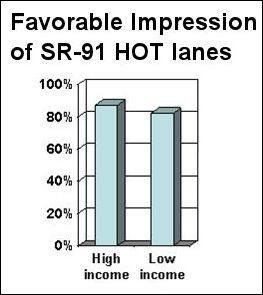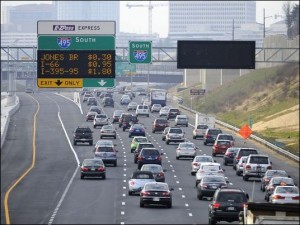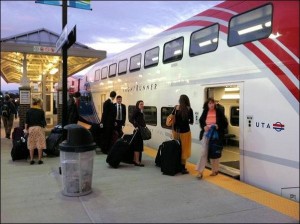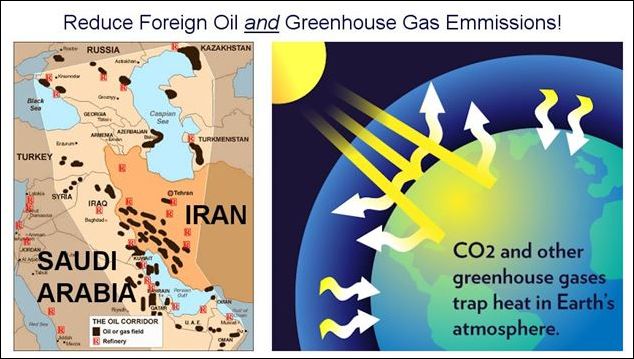by Michael Brown
This is the third part of a four-part series.
Part 1 ◊ Part 2
Part 3 ◊ Part 4
“Free” freeways aren’t as free as they used to be. Adding new capacity costs billions of dollars and mires communities in unaffordable debt. We can’t continue borrowing, taxing and building like we did a generation ago. In Parts I and II of this series, I outlined a strategy for using tolls to limit access during periods of peak demand in order to avoid the roughly 30% capacity loss caused by overloading a freeway. Not only will this Freeway Optimization strategy help preserve the environment and reduce the fiscal burden on the next generation, it will provide tangible benefits today! Here are the Top 10 Benefits of Freeway Optimization.
#10. Use more off-peak capacity
Freeways have a lot more capacity than we think. It’s just that much of the time it isn’t being used. If there are incentives to avoid peak travel, some people will shift some of their trips to off-peak periods — in effect utilizing some of that unused capacity.
#9. Triple transit ridership
Salt Lake City recently opened FrontRunner, an 80-mile commuter rail line from Ogden to Salt Lake to Provo, that competes directly with Interstate 15. The price for a monthly pass is nearly $200, which, of course, drives off some would-be riders. But how many? In the 1980s Austin, Texas, tested “free fare transit” for over a year. Ridership system-wide nearly doubled. (Hasselt, Belgium, went fare-free in 1996 and by 2006 had increased ridership 13-fold.) Austin discontinued the program in part due to complaints of vagrants and in part to insufficient capacity to handle the volume. Today, smart cards can handle the vagrancy problem. Taking the Austin experiment as a benchmark of what free transit can do, Salt Lake could use revenue from congestion pricing to reduce or eliminate the fare on FrontRunner. Austin doubled ridership in an environment where driving was free and far less congested. Imagine what could happen to ridership on Salt Lake’s FrontRunner if premium slots on I-15 at 5 pm were sold at fair market value, and proceeds were used to make FrontRunner free or very low cost! Judging from Austin, ridership could at least double if not triple!
#8. Recover lost 30% of capacity
As noted in Part 2, when the system fails, it is like having a V-8 motor that only fires on 5 cylinders — the freeway loses 30% of its capacity. Preventing failure ensures maximum value from your freeway infrastructure.
#7. Reduce spillover to side streets
A common objection to congestion pricing is that motivating drivers to leave the freeway will push them onto parallel arterials, displacing congestion from the freeways to the arterials. Seems logical, but it isn’t true. When freeways go into failure and lose 30% of their throughput, many of those drivers are already seeking other routes. With freeway optimization, the system intentionally hovers at about 5% under maximum throughput in order to avoid losing 30%. The net effect is that arterials could carry less traffic because freeways will carry more.
#6. Bring A Closer to B
When we had Free and Fast, we adopted far-flung lifestyles. There are benefits to sprawling cities but there are also many costs and side-effects. Congestion (Free But Not Fast) sets in , which forces us to shorten our overall driving – a good thing for reducing sprawl. But accepting congestion also means we’re not solving the problem, which is inefficient, frustrating and politically unacceptable. One last shot at Fast And Free requires adding capacity, which is becoming too expensive now and causes more sprawl. But a third way — Fast But Not Free using congestion pricing – can give us reliably high speeds while also discouraging excessive freeway usage. To some, that may sound like social engineering. In reality it is just free market allocation of a limited resource.
#5. Make freeways more environmentally sustainable
With pricing, you don’t need to widen freeways. Just sell premium slots to those willing to pay. Those unable or unwilling to pay for any given trip will opt instead for transit, try parallel free roads, or travel during off-peak times. The overall effect is to reduce congestion, dependence on foreign oil and the emission of Greenhouse gases – common ground for conservatives and liberals.
In part 2, I noted that we modeled what eliminating freeway congestion might be worth to Utah, and found that it could create 17,000 permanent jobs, $12 billion in additional Gross Regional Product and over $50 billion in overall societal benefit! While the pricing strategy requires a user fee, overall taxes need not increase if you use the fee to offset other taxes. Thus, pricing is not a new tax. It is part of a successful economic strategy with a higher return on investment than any other transportation project.
#3. Avoid the “Tragedy of the Commons”
 Freeways are a tremendous resource but if no one has an incentive to stay off them at 5 p.m., then drivers will overwhelm them. The system is very equitable, though – Soviet-style equal misery for everyone. If it’s too expensive to add more capacity, then use the free market to allocate what you have. When SR-91 opened HOT lanes in the Riverside, Calif., area, a survey of residents found that over 80% of low-income residents were pleased with the option for fast travel and voluntarily paid for fast travel every once in awhile.
Freeways are a tremendous resource but if no one has an incentive to stay off them at 5 p.m., then drivers will overwhelm them. The system is very equitable, though – Soviet-style equal misery for everyone. If it’s too expensive to add more capacity, then use the free market to allocate what you have. When SR-91 opened HOT lanes in the Riverside, Calif., area, a survey of residents found that over 80% of low-income residents were pleased with the option for fast travel and voluntarily paid for fast travel every once in awhile.
#2. Invest in Alternatives
It will be easier to encourage people to be somewhere else at 5 p.m. if there are good options for where else they could be. Rather than spend the next billion dollars adding a couple of lanes to a freeway, consider channeling funds into arterial streets, Bus Rapid Transit or “Innovative Intersections” that reduce delay at signalized intersections. A focus on alternatives and on improving local connectivity make it politically practical for people to tolerate the negative aspects of freeway optimization and avoid consuming the most expensive infrastructure in the state.
#1. A free market win-win that costs nothing
Instead of piling on massive debt for another temporary fix, choose a permanent fix that doesn’t cost anything. “Costs nothing?” you ask. “Then why are you collecting tolls?” If need be, adjust your gasoline tax (or other funding sources) by the amount you collect in tolls so that it truly “costs nothing” relative to the status quo. This approach can make the sum of taxes lower than today because you can avoid new debt and the taxes it would take to pay the interest and bond underwriting costs. The idea is to squeeze more capacity out of existing infrastructure and incentivize drivers to try something else. It rewards those who help solve the problem.
Michael Brown is president of Metro Analytics of Salt Lake City, Utah.





